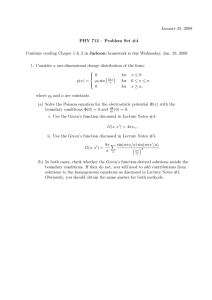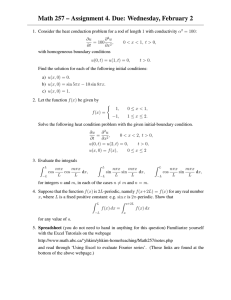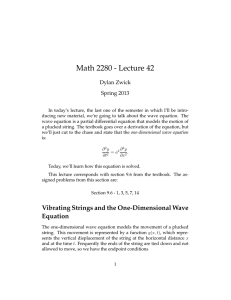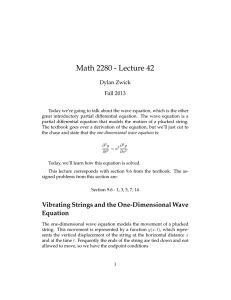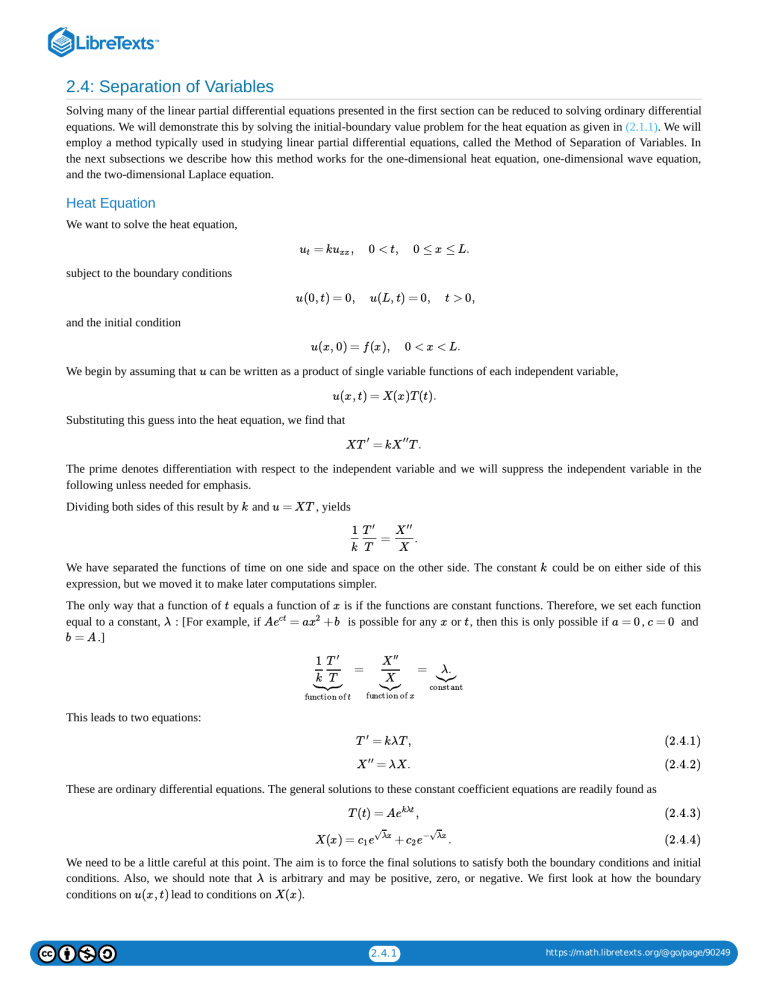
2.4: Separation of Variables Solving many of the linear partial differential equations presented in the first section can be reduced to solving ordinary differential equations. We will demonstrate this by solving the initial-boundary value problem for the heat equation as given in (2.1.1). We will employ a method typically used in studying linear partial differential equations, called the Method of Separation of Variables. In the next subsections we describe how this method works for the one-dimensional heat equation, one-dimensional wave equation, and the two-dimensional Laplace equation. Heat Equation We want to solve the heat equation, ut = kuxx , 0 < t, 0 ≤ x ≤ L. subject to the boundary conditions u(0, t) = 0, u(L, t) = 0, t > 0, and the initial condition u(x, 0) = f (x), 0 < x < L. We begin by assuming that u can be written as a product of single variable functions of each independent variable, u(x, t) = X(x)T (t). Substituting this guess into the heat equation, we find that XT ′ = kX ′′ T. The prime denotes differentiation with respect to the independent variable and we will suppress the independent variable in the following unless needed for emphasis. Dividing both sides of this result by k and u = XT , yields ′ 1 T X ′′ = k . T X We have separated the functions of time on one side and space on the other side. The constant expression, but we moved it to make later computations simpler. k could be on either side of this The only way that a function of t equals a function of x is if the functions are constant functions. Therefore, we set each function equal to a constant, λ : [For example, if Ae = ax + b is possible for any x or t , then this is only possible if a = 0 , c = 0 and b = A .] ct 2 1 T ′ X ′′ = = k T X function of t function of x λ. constant This leads to two equations: T ′ X = kλT , ′′ (2.4.1) = λX. (2.4.2) These are ordinary differential equations. The general solutions to these constant coefficient equations are readily found as T (t) = Ae X(x) = c1 e √λx kλt , + c2 e (2.4.3) −√λx . (2.4.4) We need to be a little careful at this point. The aim is to force the final solutions to satisfy both the boundary conditions and initial conditions. Also, we should note that λ is arbitrary and may be positive, zero, or negative. We first look at how the boundary conditions on u(x, t) lead to conditions on X(x). 2.4.1 https://math.libretexts.org/@go/page/90249 The first boundary condition is u(0, t) = 0 . This implies that X(0)T (t) = 0, The only way that this is true is if boundary value problem X(0) = 0 . Similarly, X ′′ for all t. u(L, t) = 0 − λX = 0, for all t implies that X(L) = 0 . So, we have to solve the X(0) = 0 = X(L). (2.4.5) An obvious solution is X ≡ 0 . However, this implies that u(x, t) = 0 , which is not an interesting solution. We call such solutions, X ≡ 0 , trivial solutions and will seek nontrivial solution for these problems. There are three cases to consider, depending on the sign of λ . λ > 0 In this case we have the exponential solutions X(x) = c1 e √λx + c2 e −√λx. (2.4.6) For X(0) = 0 , we have 0 = c1 + c2 . We will take c 2 . Then, = −c1 X(x) = c1 (e √λx −e −√λx − ) = 2 c1 sinh √λ x. Applying the second condition, X(L) = 0 yields − c1 sinh √λ L = 0. This will be true only if c 1 =0 , since λ > 0 . Thus, the only solution in this case is the trivial solution, X(x) = 0 . λ = 0 For this case it is easier to set λ to zero in the differential equation. So, X ′′ =0 . Integrating twice, one finds X(x) = c1 x + c2 . Setting x = 0 , we have c a trivial solution. 2 =0 , leaving X(x) = c 1x . Setting x = L , we find c 1L =0 . So, c 1 =0 and we are once again left with III. λ < 0 2 In this case is would be simpler to write λ = −µ . Then the differential equation is X ′′ 2 + μ X = 0. The general solution is X(x) = c1 cos μx + c2 sin μx. At x = 0 we get 0 = c . This leaves X(x) = c 1 2 sin µx . At x =L , we find 0 = c2 sin μL. So, either c 2 =0 or sin µL = 0 . c 2 =0 leads to a trivial solution again. But, there are cases when the sine is zero. Namely, μL = nπ, n = 1, 2, … . Note that n = 0 is not included since this leads to a trivial solution. Also, negative values of function is an odd function. n are redundant, since the sine In summary, we can find solutions to the boundary value problem (2.4.5) for particular values of λ . The solutions are nπx Xn (x) = sin , n = 1, 2, 3, … L 2.4.2 https://math.libretexts.org/@go/page/90249 for 2 nπ 2 λn = −μn = −( ) , n = 1, 2, 3, … . L We should note that the boundary value problem in Equation equation as (2.4.5) is an eigenvalue problem. We can recast the differential LX = λX, where d 2 L =D 2 = 2 dx is a linear differential operator. The solutions, X (x), are called eigenfunctions and the λ ’s are the eigenvalues. We will elaborate more on this characterization later in the next chapter. n n We have found the product solutions of the heat equation (2.1.1) satisfying the boundary conditions. These are un (x, t) = e kλn t nπx sin , n = 1, 2, 3, … . (2.4.7) L However, these do not necessarily satisfy the initial condition u(x, 0) = f (x). What we do get is nπx un (x, 0) = sin , n = 1, 2, 3, … . L So, if the initial condition is in one of these forms, we can pick out the right value for n and we are done. For other initial conditions, we have to do more work. Note, since the heat equation is linear, the linear combination of the product solutions is also a solution of the heat equation. The general solution satisfying the given boundary conditions is given as ∞ u(x, t) = ∑ bn e kλn t nπx sin . (2.4.8) L n=1 The coefficients in the general solution are determined using the initial condition. Namely, setting t = 0 in the general solution, we have ∞ nπx f (x) = u(x, 0) = ∑ bn sin n=1 So, if we know f (x), can we find the coefficients, problem. bn . L ? If we can, then we will have the solution to the full initial-boundary value The expression for f (x) is a Fourier sine series. We will need to digress into the study of Fourier series in order to see how one can find the Fourier series coefficients given f (x). Before proceeding, we will show that this process is not uncommon by applying the Method of Separation of Variables to the wave equation in the next section. Wave Equation In this section we will apply the Method of Separation of Variables to the one dimensional wave equation, given by ∂ 2 ∂ u 2 2 ∂ =c t ∂ 2 2 u , t > 0, ł 0 ≤ x L, (2.4.9) x subject to the boundary conditions u(0, t) = 0, u(L, t) = 0, t > 0, and the initial conditions u(x, 0) = f (x), ut (x, 0) = g(x), 0 < x < L. This problem applies to the propagation of waves on a string of length L with both ends fixed so that they do not move. u(x, t) represents the vertical displacement of the string over time. The derivation of the wave equation assumes that the vertical 2.4.3 https://math.libretexts.org/@go/page/90249 displacement is small and the string is uniform. The constant c is the wave speed, given by − − τ , μ c =√ where τ is the tension in the string and µ is the mass per unit length. We can understand this in terms of string instruments. The tension can be adjusted to produce different tones and the makeup of the string (nylon or steel, thick or thin) also has an effect. In some cases the mass density is changed simply by using thicker strings. Thus, the thicker strings in a piano produce lower frequency notes. The u term gives the acceleration of a piece of the string. The u is the concavity of the string. Thus, for a positive concavity the string is curved upward near the point of interest. Thus, neighboring points tend to pull upward towards the equilibrium position. If the concavity is negative, it would cause a negative acceleration. tt xx The solution of this problem is easily found using separation of variables. We let u(x, t) = X(x)T (t). Then we find XT ′′ 2 =c X ′′ T, which can be rewritten as 1 T ′′ X ′′ = 2 c . T X Again, we have separated the functions of time on one side and space on the other side. Therefore, we set each function equal to a constant, λ . 1 T ′′ 2 X ′′ = = T c X function of t function of x λ. constant This leads to two equations: T ′′ X 2 = c λT , ′′ (2.4.10) = λX. (2.4.11) As before, we have the boundary conditions on X(x): X(0) = 0, and X(L) = 0, giving the solutions, as shown in Figure 2.4.1, nπx Xn (x) = sin nπ , L 2.4.4 λn = −( 2 ) . L https://math.libretexts.org/@go/page/90249 Figure 2.4.1 : The first three harmonics of the vibrating string. The main difference from the solution of the heat equation is the form of the time function. Namely, from Equation have to solve T ′′ we 2 nπc +( (2.4.10) ) T = 0. (2.4.12) L This equation takes a familiar form. We let nπc ωn = , L then we have T ′′ 2 + ωn T = 0. This is the differential equation for simple harmonic motion and ω is the angular frequency. The solutions are easily found as n T (t) = An cos ωn t + Bn sin ωn t. (2.4.13) Therefore, we have found that the product solutions of the wave equation take the forms sin general solution, a superposition of all product solutions, is given by ∞ u(x, t) = ∑ [An cos n=1 nπct L nπct + Bn sin nπx L cos ωn t and sin nπx L sin ωn t . The nπx ] sin L . (2.4.14) L This solution satisfies the wave equation and the boundary conditions. We still need to satisfy the initial conditions. Note that there are two initial conditions, since the wave equation is second order in time. First, we have u(x, 0) = f (x). Thus, ∞ nπx f (x) = u(x, 0) = ∑ An sin n=1 2.4.5 . (2.4.15) L https://math.libretexts.org/@go/page/90249 In order to obtain the condition on the initial velocity, u t: t (x, ∞ nπc ut (x, t) = ∑ n=1 0) = g(x) , we need to differentiate the general solution with respect to nπct [−An sin nπct + Bn cos L L nπx ] sin L . (2.4.16) L Then, we have from the initial velocity ∞ nπc g(x) = ut (x, 0) = ∑ n=1 nπx Bn sin L . (2.4.17) L So, applying the two initial conditions, we have found that f (x) and g(x), are represented as Fourier sine series. In order to complete the problem we need to determine the coefficients A and B for n = 1, 2, 3, …. Once we have these, we have the complete solution to the wave equation. We had seen similar results for the heat equation. In the next chapter we will find out how to determine these Fourier coefficients for such series of sinusoidal functions. n n This page titled 2.4: Separation of Variables is shared under a CC BY-NC-SA 3.0 license and was authored, remixed, and/or curated by Russell Herman via source content that was edited to the style and standards of the LibreTexts platform; a detailed edit history is available upon request. 2.4.6 https://math.libretexts.org/@go/page/90249
